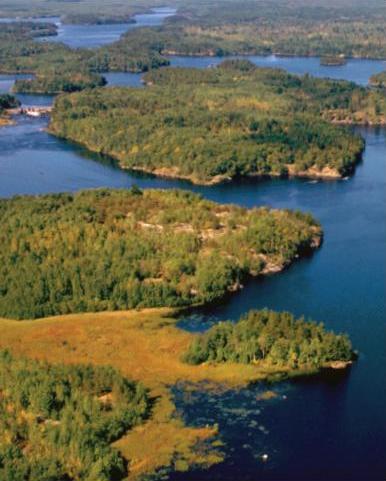By Jim Glover

When Ernest Oberholtzer was 25 years old, the Quetico-Superior country saved his life. The year was 1909. Oberholtzer, who had grown up in Davenport, Iowa, and been educated at Harvard, had heart damage caused by rheumatic fever. He’d been told he might die within a year. So that spring he headed for International Falls, Minnesota, and started canoeing.
“I felt better with every stroke of the paddle,” he later said. In fact, he felt so much better that he decided “to traverse all the major canoe routes in the Rainy Lake watershed.” And thus, as he later wrote in American Forests magazine, he and a guide “cruised the whole boundary from Pigeon River to Rainy Lake.” They also paddled the major routes in what are now Quetico and White Otter- Turtle River Provincial Parks in Ontario and several other routes just west and north of Quetico.
“I am supposed to have paddled some 3,000 miles that summer,” he later said.
And so Oberholtzer did not die that summer, nor did he for 68 more years. Instead, as American Forests put it in 1944, he went on to “ more than any other single person” to preserve the Boundary Waters/Quetico wilderness canoe region of northern Minnesota and southern Ontario.
Oberholtzer had a variety of gifts. He played classical violin, explored remote Canadian wilderness, took beautiful photographs under difficult conditions, had a noteworthy book collection, and made an exhaustive study of the Ojibwe culture.
But his greatest gift may have been this: he thought in terms of watersheds and forest ecosystems. “The whole lakeland,” he wrote, “is tilted toward the northwest and discharges its clear waters out of the north end of Lake of the Woods to Winnipeg River, Winnipeg Lake, Nelson River, and Hudson Bay.”
The landscape, moreover, had been formed by glaciers, which had “left no extensive tillable soils. The forest grows, in large part, out of the crevices of the rock. The rock is everywhere close under the moss and the leaf-mold. Destroy the all-pervading forest and every value goes with it — timber, game, recreation, beauty.”
This perspective came in handy in 1925, when an industrialist named Edward Backus revealed plans to build seven large dams in the heart of the Quetico-Superior country for hydroelectric and lumber milling purposes. Water would be backed up across an area of nearly 15,000 square miles.

Oberholtzer soon became Backus’ nemesis. Oberholtzer was hired by a newly formed group called the Quetico-Superior Council to direct their operation at a salary of $5,000 a year. He then went to work on a detailed counterproposal to Backus’ scheme.
Applying his detailed knowledge of the region, he came up with a remarkably forward-looking management plan whose single underlying purpose was to protect a 14,500-square-mile forest. The plan was based on four principles. The first was the protection of visible shorelines from “logging, flooding, or other forms of exploitation.” The second was that the outlying areas away from main waterways be used for “practical forestry” — selective, sustained-yield timber harvesting. The third was the protection of native fish and game. And the fourth was that the region be managed by a joint Canadian-U.S. commission.
To accomplish this feat, Oberholtzer proposed that three zones be established. The first and largest would be a core wilderness zone. It would include what today are known as Boundary Waters Canoe Area Wilderness (BWCA) and Voyageurs National Park on the Minnesota side; Quetico and White Otter-Turtle River Provincial Parks in Ontario; and several adjacent water routes in Ontario. The second zone would be a thin strip around the wilderness core in which summer camps and cabins would be leased and would be accessible only by water and foot trail. The third zone, farthest removed from the core, would allow private home ownership, sustained-yield forestry, and other economic uses deemed consistent with the four underlying principles. It was, in effect, a plan for an eco-region, presaging — by many years — such work as is now being done by the Coalition for the Greater Yellowstone Ecosystem. As R. Newell Searle puts it in Saving Quetico-Superior, it “was a truly prophetic vision, a plan with few known precedents.”
But unless this great plan could be put into effect, it was an academic exercise. So Oberholtzer spent several more years, with help from his competent supporters, doing the tedious legwork necessary to get state and federal legislation passed. He contacted senators and representatives, helped write bills, commented on amendments, testified at legislative hearings, met with citizens groups, appeared on radio shows, and wrote hundreds of persuasive letters. This work came to fruition in 1930 with the passage of the landmark Shipstead-Nolan Act, one of the first federal laws to recognize wilderness as a value to be protected in the public interest. Specifically, it prohibited logging within 400 feet of shorelines in Superior National Forest. And — perhaps most important at the time — it prohibited the use of dams to manipulate water levels there.
With that start, Oberholtzer was all-in as a full-time wilderness advocate. For three-and-a-half more decades, he led the conservationists’ side in a seemingly endless succession of intense debates over proposed roads, logging, mining, and tourist development along the Minnesota-Ontario border. His work contributed directly to the inclusion of BWCA in the National Wilderness Preservation System in 1964 and its expansion by 68,000 acres in 1978; Ontario’s granting of full wilderness protection to Quetico Provincial Park in 1972; and the establishment of Voyageurs National Park in 1975.
Today, those three contiguous units — BWCA, Quetico Park, and Voyageurs — combine to form a fully protected 2.4-million-acre forest, among the largest in North America. That forest, a mixture of Great Lakes hardwoods and northern conifers, is Oberholtzer’s legacy. Thanks to him it remains, as he once observed, “one of the rarest of all regions of the continent, if not the world.”
Jim Glover writes from Carbondale, Illinois, and can be reached at gonecat@yahoo.com.